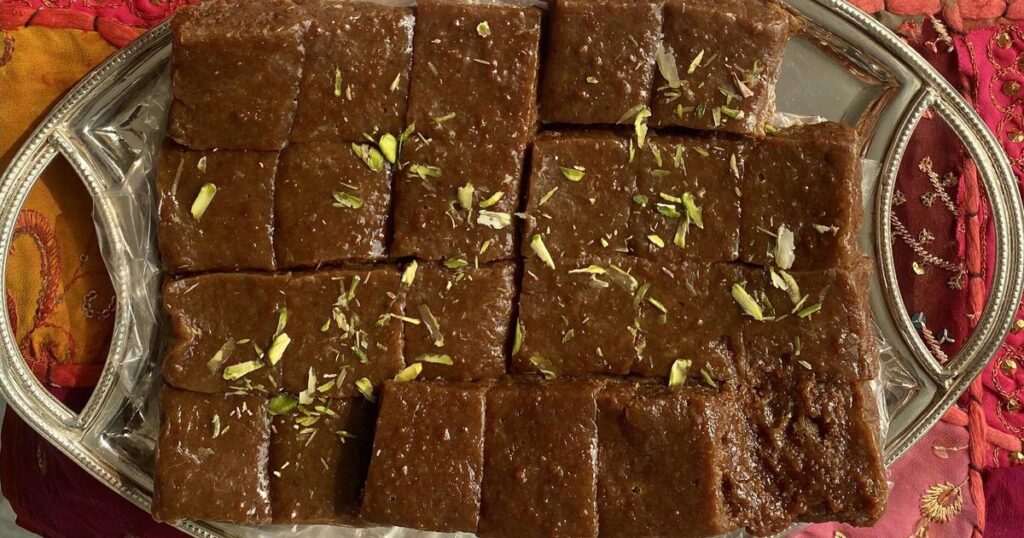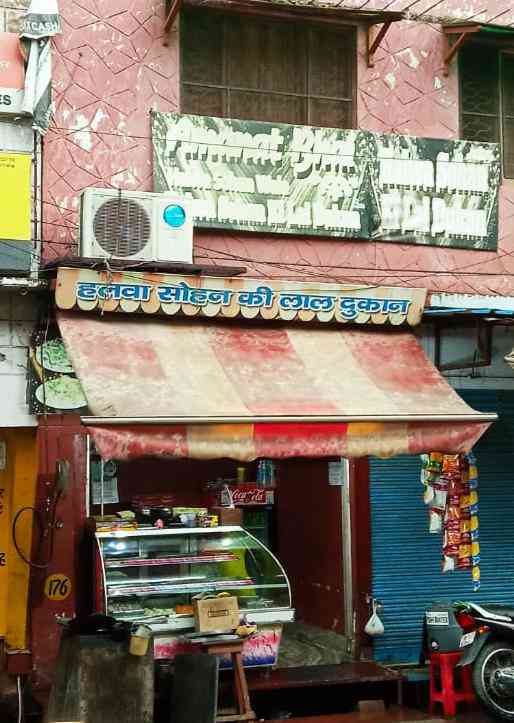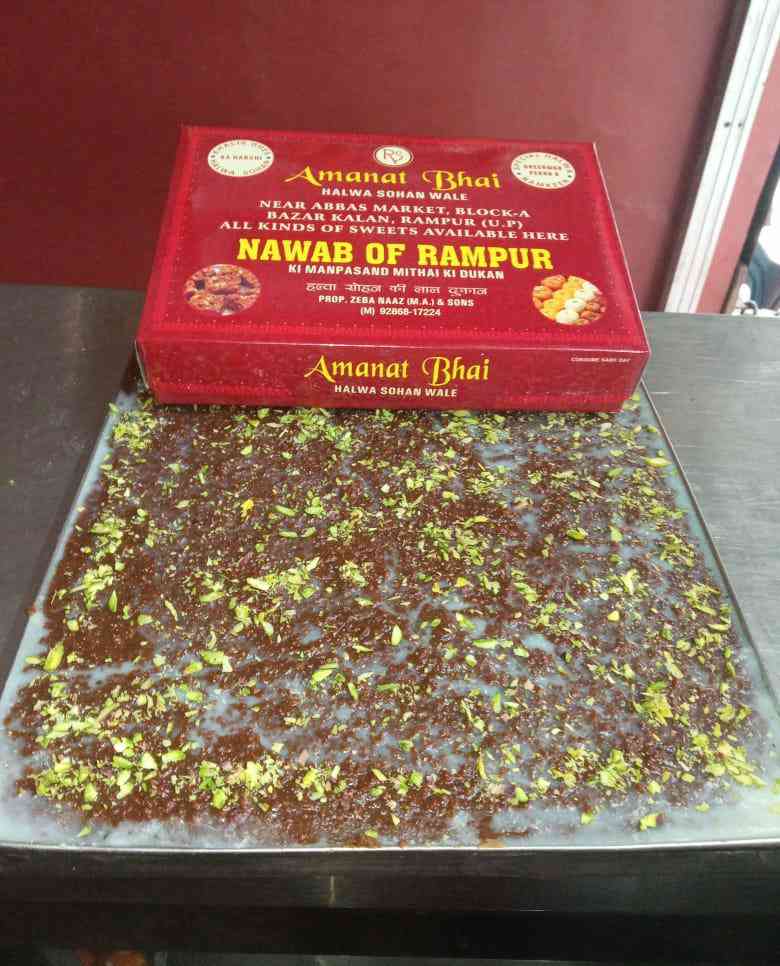Rampur, UTTAR PRADESH :
The halwa sold today is not the halwa of my childhood. It has been revised, adapted, diminished, like so many sweetmeats of times past.

Tarana Husain Khan
My childhood winters could not be considered complete without Rampur halwa sohan from the shop of Amanat Bhai. The halwa used to come in a crimson and gold box with, appropriately enough, the words “mausam e sarma ka tohfa”, meaning the gift of winters, written across it.
Like mutable memories, the halwa sohan of Rampur too has changed. For one, the “gift of winters” is now available throughs the year. For another, it no longer tastes the same. The texture used to be finer in my childhood, each piece coalescing with the barely visible ghee, leaving behind not a smidge of aftertaste. The halwa today has a thick, grainy texture. It is crumblier and instead of the old red-brown, it is of a darker brown hue with a sheen of glistening ghee.
This confounding degeneration led me to Amanat Bhai ki laal dukaan in Rampur’s ancient Nasrullah Khan bazar. Maybe they could give a ready explanation for the decline. The shop is not hard to find. Its rouge walls, which gave rise to the vivid name, distinguishes it from the other stores outside the qilla.
Haris Raza, the grandson of Amanat Bhai who runs the shop, informs me that it dates to the time of Nawab Raza Ali Khan (1930-1949). Its founder Amanat ulla Khan learned the art of making halwa sohan from his father and used to prepare it, along with gulqand (a rose petal sweet), for Nawab Raza. There are now two Amanat Bhai shops, each run by a different branch of the old maestro’s family, each claiming to possess the genuine recipe.

Amanat Bhai ki laal dukaan. Courtesy: Tarana Husain Khan.
At Rs 600 a kilogram, halwa sohan today is not hard on the pocket of the ordinary man. I believe it is to achieve this economy that the ingredients and their proportions have been altered. Where the older recipe used genuine ghee, the newer one employs ghee substitutes, possibly contributing to the aftertaste.
Haris says he makes special halwa sohan for members of the royal family with large quantities of pure ghee. But even this possesses the same grainy and burnt dark brown look as the everyday one. There is also an overpowering taste of caramel to it. Haris lays the blame on the evolving palate: customers’ preferences have changed. He nods when I describe the halwa sohan of my childhood. “Khaane pe ghee ki pichkaari nikalti thi,” he exclaimed. When you ate it, ghee would squirt in the mouth.
We go up the rough steps to the kitchen above the shop. Haris shows me pictures of celebrity chef Kunal Kapur stirring halwa in a large kadhai and asks if I have watched the episode of The Royal Palate in which the chef visited his shop. I tell him I have, but that is not how I know of the shop. My association with it goes back far longer. He smiles and decides to call me Appi (elder sister). He says he was compelled to give up his fledgling career as a real estate agent and take over the family business in 2016 after his father’s sudden death. It was important for him to continue the family tradition.
As I watch the cooks working furiously over large steaming kadhais, Haris enlightens me on the finer points of halwa-making. The process is as lengthy as it is laborious. It all starts with the making of samnak or wheat germ. The grains are first sifted for broken or blackened seeds and then soaked in water for three days. Great care must be taken at this stage. When the sprouts are about an inch long, they are dried and then ground to a flour. Next the flour is dissolved in just enough milk to make a thick paste. The rest of the milk is added in splashes while sautéing.
The halwa gets its sweet caramel flavour and dark red-brown colour from being sautéd in a kadhai for a long time. According to Haris, the normal cooking in the past was six hours, but now they cook it for nine hours because customers – including the erstwhile royal family – prefer a darker colour. Once cooked, the halwa is spread on trays, sprinkled with pistachio juliennes, and cut into squares. Each chewy soft square with its sweet and caramel taste is still delectable.
Haris says it takes a halwai years of practice to get everything right, from the intensity of the sauté to the timing of when to add the ingredients. At precisely the right time, a little alum must be tossed in to curdle the milk and effect a daana, or grainy texture, in the halwa. Just one error can make the difference between adequate and delicious. Most halwais, Haris explains, make the mistake of adding all the milk with the flour.

courtesy: Tarana Husain Khan.
Haris admits to reducing the amount of ghee and sugar in the recipe. The earlier proportion was 40 litres milk, 2 kilograms samnak flour, 1 kilogram semolina, 7 kilograms ghee and 10 kilograms sugar. His cooks use the semolina to get the crumbly texture and darker colour. But the recipes I discovered in my research of 19th century cookbook manuscripts and a 1940s cookbook did not use semolina, but instead a small proportion of maida (refined flour) with samnak flour. Maybe that is the reason for the different texture. Haris has no idea when they changed the ingredients. He checks my profile on Google and promises to make the old-style halwa for me.
Origin Story
Oral history narrated by Rampur’s cooks credits the royal hakims for the recipe of halwa sohan and other halwas. However, given halwa sohan’s popularity in Afghanistan and parts of Pakistan, it is safe to assume that it was the Rohilla community that carried the rustic samnak halwa to India. Once here, the recipe was made more elaborate in the royal kitchens of Rampur.
The test of the famed halwa sohan, once called habshi halwa, was that when placed on a dish, it would show no sign of the ghee. However, if you stabbed it with a finger, the ghee would gather around the finger, only to disappear again once the finger was removed. This sounds remarkable considering there was 10 to 12 times the amount of ghee than the flour.
Muneeza Shamsi, a writer and a niece of Raffat Zamani Begum of Rampur (1907-1986), says the halwa sohan she used to eat at Khasbagh Palace in the 1960s could never be replicated. Equally impressed was Rampur historian Ali Asghar Shadani, who described the halwa sohan of Rampur in Ahwal e Riyasat e Rampur years after he migrated to Pakistan:
“When you put a piece of halwa sohan or habshi halwa in your mouth, it starts melting immediately. The taste is heavenly and it never sticks to the tooth or irritates the throat. If you ate the halwa sohan cooked by a Rampur khansama, you would forget Abdurrazaq khansama’s halwa served at Ghanta Ghar, Delhi.”
Halwa sohan would be cooked through the night before a wedding or a grand celebration. Cooks would be given a corner of the courtyard and a large kadhai set over open fire as guests came in with gifts and sang songs for the bride. Each square of the halwa was packed into a box bearing the names of the couple and the boxes then distributed to the groom’s family and guests after the nikah (nuptial vows). The in-laws would be given several boxes.
Well-cooked halwa sohan doesn’t spoil for a long time and requires no refrigeration. My brother’s wife and her family from Lucknow, who fell in love with the halwa, stored it for more than a year. The nikah sweets these days tend to be boondi ladoos rather than halwa. This is because, like me, most Rampuris feel that halwa sohan doesn’t taste the same anymore.
Nasreen Begum, the wife of Nawab Raza Ali Khan’s nephew, told me she used to cook halwa sohan at home with the help of her khansamas. She is now too old to supervise cooking, the old khansamas have passed away, and she has to depend on the local halwai for her supply. There are barely any khansamas willing to cook it at home these days, so for special occasions people order halwa sohan from their local shops.
Aloe Vera Or Adrak
A popular variant of halwa sohan in Rampur is doodhiya halwa sohan. The ingredients of this variant are the same – samnak and wheat flour form the base – but the higher proportion of milk changes its colour and taste. The way it is cooked is similar to the way halwa sohan is cooked in Multan and Afghanistan – the flours are dissolved into the milk and then cooked – although Afghans generally use curd to curdle the milk. Apart from doodhiya halwa, there are other variants. Jauzi halwa sohan uses the same ingredients but has a lighter colour because it is sautéed for less time. Papdi halwa sohan is hard and biscuit-like.
Haris says his late father added aloe vera halwa to the menu some 20 years ago because aloe vera was a fad then. It still survives on the menu and is in high demand every winter as a remedy for joint pain. I found no mention of aloe vera halwa in the historical sources on Rampur cuisine. Instead, for join pain relief, people used to prefer adrak halwa in the olden days.
Several articles on Rampur cuisine based on oral history mention adrak halwa. The story goes that a nawab suffering from joint aches was prescribed ginger or a ginger-based medicine, which he absolutely loathed. As a workaround, his cooks were asked to create a ginger-based halwa in such a way that the nawab should never suspect he was being fed the detested tuber. The cooks succeeded and from their ingenuity sprang adrak halwa.
Old texts advocate the use of young ginger stems with a light greenish hue, so that there are no fibres to spoil the texture and produce an aftertaste. Rampuri adrak halwa is a speciality that can still be found at local shops. Amanat Bhai’s shop offers it too, along with aloe vera halwa, though given the amount of ghee and sugar in them, they cannot be said to be healthy by any stretch of the imagination.
Forgotten Sweetness
Beyond halwas, Rampur’s cuisine has other heavenly desserts. Some have been incorporated from Mughal and Awadh cuisines, while others were born of the creativity of royal khansamas. Remembrances of Days Past: Glimpses of a Princely State, a memoir of Jahanara Habibullah, the sister of Raffat Zamani Begum, describes in details the sweetmeats loved by the Rampur nawabs.
Rice-based desserts such as zarda (sweet rice with saffron) and safeda (sweet rice) are all-time favourites that are served at weddings and banquets. Safeda is a sweet rice that is cooked in five times the amount of sugar until each grain of rice attains the sheen of sugar syrup. Zarda, by contrast, is less sweet and is dyed zard (yellow) with saffron and food colouring.
I, for one, have never understood the logic of serving zarda or any sweet rice with savoury pulao – it is too much rice for me in a feast. Maybe one explanation for this profusion of rice dishes is that Rampur lies in a rice-growing belt.
On the royal tables, zarda was embellished with fruits fashioned out of sugar – an art of presentation that lives on through food memoirs. Begum Noor Bano recalls that the Basmati rice for zarda and safeda used to come from Tanda tehsil of Rampur and had to be matured for 10 years for it to absorb the large amounts of sugar. We now have at best two-year-old rice, and double the sugar is all we can aspire for. To make matters simpler, cooks today use parboiled rice, which I find a bit too firm, almost plasticky and with zero aroma.
In the 1960s, the last years of grand Rampur cuisine, my husband and his brother attended a royal banquet with their grandfather, Ameer Ahmad Khan. This distinguished gentleman, who was the chief secretary to the nawab at the time, kept an eagle eye on his young wards. The meal was a buffet. As one of the boys reached for what looked like a kabab to go with the poori, Ameer Ahmad Khan abandoned his circle and pounced on the errant grandson, confiscating his plate.
“Idiot! This is hubaabi, not kabab,” he hissed.
Hubaabi was a deep-fried sweet dipped in sugar syrup that looked like a round kabab. The poor boy, too shy to get another plate, came home hungry, and the episode became a part of family lore.
By the 1960s, some Rampur sweets became confined to the royal tables and were unrecognisable to the ordinary populace. One of them was hubaabi. Made of maida, sugar, milk and ghee, hubaabi required a perfect khameer (yeast) to rise or the spheres would become flat and harden while frying. Mangochi (sweet moong dumplings), sheer badey (sweet urad dumplings), gul e akbari (almond flour sweet), qutub khani (fried maida sweet) were other sweets that got relegated to food memories.
Jahanara Habibullah mentions the sweet dar e bahist (gateway to heaven) in her memoir. It is an almond-based sweet, shaped like a thick, large barfi. It is difficult to make because the pastry of almond flour, sugar and milk has to be cooked to the moment when the surface bubbles into holes – the jaali point. It is then taken off the heat, spread out on a flat tray and cooled. Next it is cut into two-inch squares. It is the flakiness of the jaali that is difficult to achieve. I have only heard and read descriptions of dar e bahist and I’m assuming that if the crucial point is missed, the texture and taste changes. Maybe it was the arduous cooking procedure, the expense or the fall in demand which led to its discontinuation. Haris says he makes it sometimes for members of the royal family on special occasions. There are several variations of the dar e bahist described in old cookbooks – made with pistachios, chickpea flour, rose petals, or coconut – several gateways to heaven where none exist now.
In the late 1960s and early 1970s, the struggling elite sold their lands to survive. The loss of the privy purse in 1971 left the royalty strapped for cash, and one of the casualties of the resulting parsimony was the cuisine. The more expensive dishes were excluded from the royal menu and slowly forgotten. For other dishes, ingredients were replaced, procedures abridged, and general cost-cutting measures adopted. The fate of halwa sohan, as of other sweets, was sealed. The nawabs let go of the royal cooks and depended on halwais for those sweets that used to be cooked in their kitchens.
An invite from Nawab Kazim Ali Khan to the wedding of his son last year was accompanied by a large box of halwa sohan. Prepared from the old recipe at Amanat Bhai’s shop, it had the fine texture and the elusive red-brown hue with the sheen of ghee. I took a tentative bite of a soft square. It melted in the mouth, an amalgam of earthy and caramel flavours, a satiating whole with an approximation of the well-remembered and much-loved taste.
This article is part of the project “Forgotten Food: Culinary Memory, Local Heritage and Lost Agricultural Varieties in India”, curated by Tarana Husain Khan and edited by Siobhan Lambert Hurley and Claire Chambers. It has been funded by Global Challenges Research Fund through the Arts & Humanities Research Council in the United Kingdom. Read the other parts here.
source: http://www.scroll.in / Scroll.in / Home> Forgotten Food / by Tarana Husain Khan / June 05th, 2021








